
Spaces and places, as well as landscapes and territories, are determining themes in Marina Camargo’s artwork. A series of broadly based works deals with specific landscapes, which are artistically questioned in their capacity as territories. These are primarily the transnational landscapes of the Alps in Alpine Project (since 2011) and the Pampas in Tratado de Limites (Treaty of Limits, 2011), as well as the northeastern Brazilian Sertão in Como se faz um deserto (The making of a desert, 2013). In the works mentioned above, various facets of territory are subjected to a profound reflection, especially the meanings of “geographically delimited territory” and “areas of dominance.” The aesthetic strategies employed here refer to the history of the corresponding landscapes and their representations, which in the case of the Pampa and the Sertão refer to the (hidden) presence of the colonial past. Camargo’s multilayered artistic examination of specific territories is illustrated here using the example of Como se faz um deserto. The artist’s book deals with the Sertão, a vast region in northeastern Brazil’s interior with a characteristic geographic and cultural influence.
Como se faz um deserto is characterized by a double approach: on the one hand, through the targeted appropriation of representations of the Sertão that have been created since colonial times; on the other hand, through photographs and written reflections by the artist, based on a journey she undertook in 2012 to explore the Sertão. Camargo uses the book medium in a way that corresponds to the rhizomatic “principle of connection and heterogeneity,” as described by Gilles Deleuze and Félix Guattari in Thousand Plateaus (Mille Plateaux, 1980). The rhizomatic structure of Como se faz um deserto already manifests itself in the book cover with its paratextual markings and manifold references. While “the Sertão” seems to be immediately recognizable on the cover through the iconic photograph of a landscape with red earth, which also determines the cover’s color scheme, this impression is questioned by the title. Thus the phrase “The making of a desert” refers to the construction of a particular landscape. The term desert serves less as a geographical designation – which would be wrong concerning the Sertão – than as a metaphor in the sense of a hostile, sparsely populated area marked by drought and poverty. These meanings, which are based on the word field of the desert, have shaped the discourse on the Sertão since the European colonization of this area up to the present day.
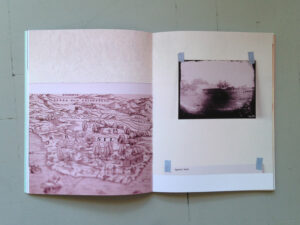 Characteristic of the rhizomatic structure of Como se faz um deserto, the book contains a historical photograph that depicts the same motif as on the cover: a simple habitation between the barren ground and the vast sky, surrounded by a fence of stakes. This photograph by the naturalist Louis Agassiz was taken in 1865 during his expedition through Brazil, from which the book publication A Journey in Brazil emerged shortly afterward. The similarity of the houses depicted by Agassiz and Camargo could give the impression that the Sertão is a place of the past. This temporality corresponds to an attribution that continues to influence discourse to this day, which either stigmatizes the Sertão as being backward or connects it positively with originality. On the other hand, Camargo merely calls up these abbreviated representations to reflect critically on them and make the complexity of the Sertão comprehensible. Thus the small-format photograph on the cover reappears in the book and takes up two pages. In the image of the same photo, which is twice as large, details emerge that are barely visible on the cover. As can now be seen, the house is connected to the electricity grid and has a parabolic antenna. The large-format photograph thus testifies to the combination of tradition and modernity in the Sertão. Camargo’s double iterated photographic representation of a “typical” dwelling is not under the sign of mythical timelessness, but instead of historicity and the critical reflection of discourse formations on the Sertão. This approach is not limited to inter-pictorial references. As the binding of Como se faz um deserto already makes clear, the pictorial references are elements of a rhizomatic network that also includes numerous inter-textual and inter-medial connections.
Characteristic of the rhizomatic structure of Como se faz um deserto, the book contains a historical photograph that depicts the same motif as on the cover: a simple habitation between the barren ground and the vast sky, surrounded by a fence of stakes. This photograph by the naturalist Louis Agassiz was taken in 1865 during his expedition through Brazil, from which the book publication A Journey in Brazil emerged shortly afterward. The similarity of the houses depicted by Agassiz and Camargo could give the impression that the Sertão is a place of the past. This temporality corresponds to an attribution that continues to influence discourse to this day, which either stigmatizes the Sertão as being backward or connects it positively with originality. On the other hand, Camargo merely calls up these abbreviated representations to reflect critically on them and make the complexity of the Sertão comprehensible. Thus the small-format photograph on the cover reappears in the book and takes up two pages. In the image of the same photo, which is twice as large, details emerge that are barely visible on the cover. As can now be seen, the house is connected to the electricity grid and has a parabolic antenna. The large-format photograph thus testifies to the combination of tradition and modernity in the Sertão. Camargo’s double iterated photographic representation of a “typical” dwelling is not under the sign of mythical timelessness, but instead of historicity and the critical reflection of discourse formations on the Sertão. This approach is not limited to inter-pictorial references. As the binding of Como se faz um deserto already makes clear, the pictorial references are elements of a rhizomatic network that also includes numerous inter-textual and inter-medial connections.
The title Como se faz um deserto is a quote from Euclides da Cunha’s book Os Sertões: Campanha de Canudos (War in the Sertão) was published in 1902 and since then has significantly influenced the idea of the Sertão. In a synthesis of novel and essay, scientific treatise of various natural history disciplines and contemporary historical report, especially on the massacre of Canudos, Euclides da Cunha achieves a comprehensive representation of the territory, which he calls “Sertões” in the plural. His text alternates between a social and natural scientific style and an emphatically poetic form of expression; precise, sober descriptions alternate with formulations of high metaphorical ambiguity and sonority, whereby these different registers combine to form a unique style.
Como se faz um deserto not only contains concrete references to Euclides da Cunha’s discourse-forming work; moreover, there are structural similarities between the two works. Comparable to Camargo’s book, Os Sertões already evades the fixation on a specific genre and is characterized by a plurimedial design with numerous intertextual references. Setting a field of tension between various genres and ways of writing multiple media flow into the book: different maps on the geology, geography, and flora of the Sertão, three contemporary photographs by Flávio de Barros of Canudos, and a drawing of the Caatinga, a landscape in the Sertão taken from the book Brazil and the Brazilians (1857) by Daniel P. Kidder and James C. Fletcher and also taken up by Marina Camargo in Como se faz um deserto.
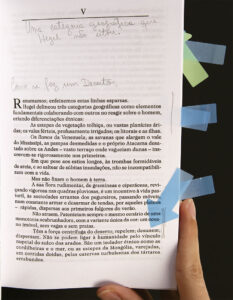 Camargo refers almost as a leitmotif to the first part of Os Sertões, titled “A Terra” (“The Land”), which characterizes the Sertão mainly in geographical, geological, and biological terms. In the form of photographic images, the artist takes up four text passages from da Cunha’s publication. These photographs are not merely reproductions of specific pages of a book; instead, they express Camargo’s personal reading, through which she makes specific passages from Os Sertões her own. Thus the selected text passages are emphasized through image details and selective sharpness, and recontextualized through various procedures: both through the sequence of pages with the resulting specific arrangement of images, texts, and maps, and through image montage – for example, when the edge of a book page of Os Sertões is continued in the horizon line of a landscape photograph of the Sertão. The pictures also testify to the performative treatment of da Cunha’s work, for example, through the presence of Camargo’s hand on individual pages of the book and underlining and further text-markings. Particularly significant is a photograph depicting the beginning of the 5th chapter of “A Terra,” on which the artist handwritten two headings from the first part of Os Sertões: “Como se faz um deserto”, title and central idea of the artist’s book, and “Uma categoria geográfica que Hegel não citou” (“A geographical category not mentioned by Hegel”). On the page mentioned above, da Cunha refers to the definition of the “geographical differences” in the highlands, the valley floor, and the shore area, which Hegel made in lectures on philosophy’s history (1833-36). In the course of the chapter, he complains that Hegel lacked the “sertões do Norte,” to which he dedicates his comprehensive book as a separate geographical category. Nevertheless, da Cunha ultimately follows certain assumptions of Hegel, especially his geo-deterministic world view. Furthermore, he uses category formation and classification as an elementary means of knowledge to represent the Sertão.
Camargo refers almost as a leitmotif to the first part of Os Sertões, titled “A Terra” (“The Land”), which characterizes the Sertão mainly in geographical, geological, and biological terms. In the form of photographic images, the artist takes up four text passages from da Cunha’s publication. These photographs are not merely reproductions of specific pages of a book; instead, they express Camargo’s personal reading, through which she makes specific passages from Os Sertões her own. Thus the selected text passages are emphasized through image details and selective sharpness, and recontextualized through various procedures: both through the sequence of pages with the resulting specific arrangement of images, texts, and maps, and through image montage – for example, when the edge of a book page of Os Sertões is continued in the horizon line of a landscape photograph of the Sertão. The pictures also testify to the performative treatment of da Cunha’s work, for example, through the presence of Camargo’s hand on individual pages of the book and underlining and further text-markings. Particularly significant is a photograph depicting the beginning of the 5th chapter of “A Terra,” on which the artist handwritten two headings from the first part of Os Sertões: “Como se faz um deserto”, title and central idea of the artist’s book, and “Uma categoria geográfica que Hegel não citou” (“A geographical category not mentioned by Hegel”). On the page mentioned above, da Cunha refers to the definition of the “geographical differences” in the highlands, the valley floor, and the shore area, which Hegel made in lectures on philosophy’s history (1833-36). In the course of the chapter, he complains that Hegel lacked the “sertões do Norte,” to which he dedicates his comprehensive book as a separate geographical category. Nevertheless, da Cunha ultimately follows certain assumptions of Hegel, especially his geo-deterministic world view. Furthermore, he uses category formation and classification as an elementary means of knowledge to represent the Sertão.
Although in Como se faz um deserto, a particular elective affinity to Os Sertões is discernible, there are fundamental differences between the two works. While Euclides da Cunha ultimately adheres to a positivist worldview, represents a geo-determinist way of thinking, and makes classificatory classifications, Camargo critically reflects these approaches. Thus, her depiction of the Sertão is characterized by the search for a place that eludes. Camargo reflects the insights resulting from her travel experience in an essay in the artist’s book entitled “No Sertão da calma do pensamento” (“In the Sertão of Thoughtful Tranquility”). By turning away from the “sertão of stereotypes,” the artist finds herself confronted with an “unreachable place” in the face of “the many places that are considered Sertão. Camargo’s attempt to trace “the Sertão” is expressed in the way the process of creating the artist’s book is incorporated into the representation of this territory. A double-page photograph towards the end of the book, showing the artist’s studio, is revealing: on the wall is a collage of various texts and pictures, a drawing and, above all, maps; in front of it is a tripod, a table with work utensils and the book Os Sertões by Euclides da Cunha. Many of the depictions of the Sertão on the studio wall appear in close-ups on previous pages. Using the media-specific design possibilities of book, photography, and writing, it becomes clear how Camargo modifies the representations of the Sertão she has taken up and makes them an integral part of her artist book.
In addition to excerpts from Os Sertões, the artist’s book includes another literary text: “Histórias no Sertão, areia em Jericoacoara” (“Stories in the Sertão, Sand in Jericoacoara”) by Gonçalo M. Tavares. The contemporary Portuguese author thematizes the Sertão and the coast as complementary themes in the form of a literary travelogue. He sketches out drafts of 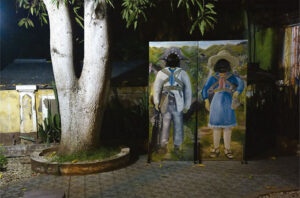 an alternative narrative and cartography that correspond to Camargo’s depiction of the Sertão in their procedure and performativity. Concerning the tradition of storytelling in the Sertão, Tavares raises the question of whether a different story emerges from the narrators’ hand movements than from verbal description. And given the ever-changing dune landscape of Jericoacoara, he evokes “a diverse geography, a half-dancing geography, in because of the ephemeral mountains always seem to mock the cartographer.” In Camargo’s book, Tavares’s text is embedded in a complex structure of manifold connections and correspondences. His storytelling ideas refer to the Cangaceiros Lampião and Maria Bonita, which are already depicted in the artist’s book storytelling ideas in an unusual way. In a high-contrast photograph, one sees a picture backdrop at the side of the road with the two legendary “cangaceiros” whose faces appear as dark voids. Camargo’s photography bears witness to the effective representation of the motif in Chiaroscuro of the figure of the “cangaceiro” as the mythical emblem of the Sertão, which on the one hand appears as a stereotype and on the other hand, is continuously renewed through re-iterations, as in Como se faz um deserto. Through her photography and Tavares’ text, Camargo implicitly refers to the important tradition of depicting “cangaceiros” in Brazilian popular and high culture, for example, in the Literatura de Cordel and songs by Luiz Gonzaga, but also in paintings by Candido Portinari and in the prose of João Guimarães Rosa, in plays by Raquel de Queiroz and in films by Glauber Rocha, to name but a few examples.
an alternative narrative and cartography that correspond to Camargo’s depiction of the Sertão in their procedure and performativity. Concerning the tradition of storytelling in the Sertão, Tavares raises the question of whether a different story emerges from the narrators’ hand movements than from verbal description. And given the ever-changing dune landscape of Jericoacoara, he evokes “a diverse geography, a half-dancing geography, in because of the ephemeral mountains always seem to mock the cartographer.” In Camargo’s book, Tavares’s text is embedded in a complex structure of manifold connections and correspondences. His storytelling ideas refer to the Cangaceiros Lampião and Maria Bonita, which are already depicted in the artist’s book storytelling ideas in an unusual way. In a high-contrast photograph, one sees a picture backdrop at the side of the road with the two legendary “cangaceiros” whose faces appear as dark voids. Camargo’s photography bears witness to the effective representation of the motif in Chiaroscuro of the figure of the “cangaceiro” as the mythical emblem of the Sertão, which on the one hand appears as a stereotype and on the other hand, is continuously renewed through re-iterations, as in Como se faz um deserto. Through her photography and Tavares’ text, Camargo implicitly refers to the important tradition of depicting “cangaceiros” in Brazilian popular and high culture, for example, in the Literatura de Cordel and songs by Luiz Gonzaga, but also in paintings by Candido Portinari and in the prose of João Guimarães Rosa, in plays by Raquel de Queiroz and in films by Glauber Rocha, to name but a few examples.
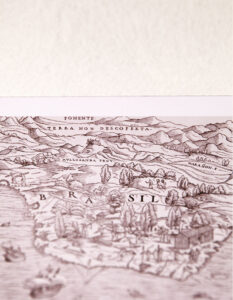 In addition to the two literary texts by da Cunha and Tavares, Como se faz um deserto also includes two scholarly essays that discuss the conceptual history of the Sertão and the cartographic representation of the territory. In keeping with the artist’s book’s rhizomatic structure, the two research essays are supplemented by other sources spread throughout the book, creating new meaning concerning the various representations of the Sertão. Complementing the piece with its critical scientific reflection on the “cartographic construction” of the Sertão, the book contains numerous historical maps of the territory. These include a cartographic representation by Giacomo Gastaldi from 1565, in which the Sertão is described as “Terra non descoperta” (“Undiscovered Land”), while later, increasingly detailed maps implicitly testify to the colonization of the country. In addition to the conceptual history essay, Camargo included definitions of the Sertão from historical dictionaries in Como se faz um deserto. Thus, the artist’s book’s first page contains an entry from the Diccionario da lingua Portuguesa (1813) by António de Moraes Silva, defining the Sertão meaning the interior of the country as an ex negativo to the coast. An almost identical definition can be found in the entry from the Diccionario da língua Brasileira (1832) by Luiz Maria da Silva Pinto, which is also photographed by Camargo. Similar to the dictionaries, in which the Sertão is merely the opposite pole of the coast, such binary forms of thought still characterize the representation of this territory today – since the 20th century, mostly in contrast to the relatively prosperous southeast of Brazil. With Marina Camargo, on the other hand, the Sertão does not appear as a further variant of the standard, supposedly typical representations. Instead, in her artist’s book, she creates a rhizomatic network of diverse texts and pictorial forms. The result is a kaleidoscopic changing image that is characterized by deviation, difference, and multiplicity. In this way, Como se faz um deserto bears witness to the Sertão as an atopic territory.
In addition to the two literary texts by da Cunha and Tavares, Como se faz um deserto also includes two scholarly essays that discuss the conceptual history of the Sertão and the cartographic representation of the territory. In keeping with the artist’s book’s rhizomatic structure, the two research essays are supplemented by other sources spread throughout the book, creating new meaning concerning the various representations of the Sertão. Complementing the piece with its critical scientific reflection on the “cartographic construction” of the Sertão, the book contains numerous historical maps of the territory. These include a cartographic representation by Giacomo Gastaldi from 1565, in which the Sertão is described as “Terra non descoperta” (“Undiscovered Land”), while later, increasingly detailed maps implicitly testify to the colonization of the country. In addition to the conceptual history essay, Camargo included definitions of the Sertão from historical dictionaries in Como se faz um deserto. Thus, the artist’s book’s first page contains an entry from the Diccionario da lingua Portuguesa (1813) by António de Moraes Silva, defining the Sertão meaning the interior of the country as an ex negativo to the coast. An almost identical definition can be found in the entry from the Diccionario da língua Brasileira (1832) by Luiz Maria da Silva Pinto, which is also photographed by Camargo. Similar to the dictionaries, in which the Sertão is merely the opposite pole of the coast, such binary forms of thought still characterize the representation of this territory today – since the 20th century, mostly in contrast to the relatively prosperous southeast of Brazil. With Marina Camargo, on the other hand, the Sertão does not appear as a further variant of the standard, supposedly typical representations. Instead, in her artist’s book, she creates a rhizomatic network of diverse texts and pictorial forms. The result is a kaleidoscopic changing image that is characterized by deviation, difference, and multiplicity. In this way, Como se faz um deserto bears witness to the Sertão as an atopic territory.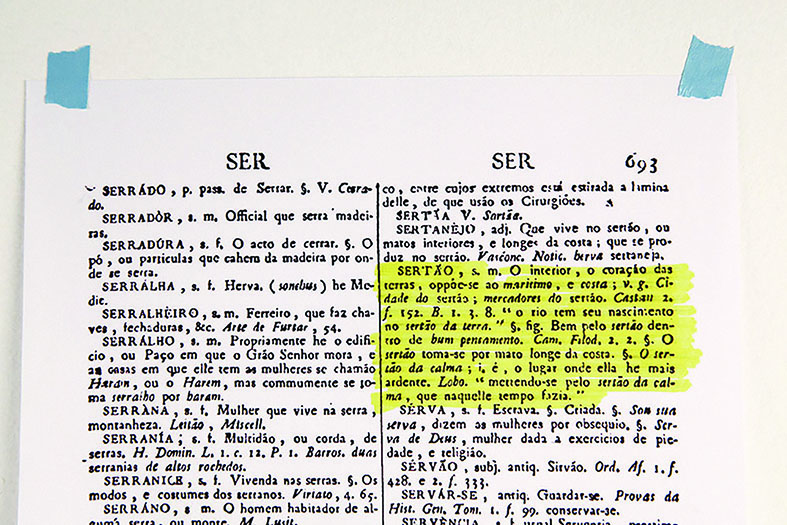
Text originally published in the book Marina Camargo: der Ort danach | O lugar depois, organized by Peter W. Schulze and Claudia Cuadra (Universität zu Köln – Germany, 2019)